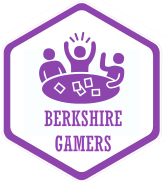9/24/2025 – Berkshire Gamers Session Report #25-38
-
by BerkshireGamers
- 97
Set-up includes randomly placing large hexagonal tiles (each depicting one of the five resource-producing terrain types–or the desert) in a honeycomb shape and surrounding them with water tiles, some of which contain ports of exchange. A number disk, the value of which will correspond to the roll of two 6-sided dice, are placed on each terrain tile. Each player is given two settlements (think: houses) and roads (sticks) which are placed on intersections and borders of the terrain tiles. Players collect a hand of resource cards based on which terrain tiles their last-placed settlement is adjacent to. A robber pawn is placed on the desert tile.
A turn consists of rolling the dice, collecting resource cards based on this dice roll and the position of settlements (or upgraded cities—think: hotels), turning in resource cards (if possible and desired) for improvements, trading cards at a port, possibly playing a development card, or trading resource cards with other players. If the dice roll is a 7, the active player moves the robber to a new terrain tile and steals a resource card from another player who has a settlement adjacent to that tile.
Points are accumulated by building settlements and cities, having the longest road or the largest army (from some of the development cards), and gathering certain development cards that simply award victory points. When a player has gathered 10 points (some of which may be held in secret), they announce this and claim victory.
The 1904 Edition of Pit added much fancier artwork and the famous Bull and Bear cards, which provide wild-card and penalty features. The early editions allowed a maximum of 7 players, but later versions supported 8 and in at least one case up to 10.
15 at the UNO Park Community Center in North Adams for an evening of trading games, marketplaces and bazaars 9/24/2025 @ UNO Park Community Center IN: Steve & Sandy, Ethan & Amy, Tim, Armando, Zach, Nicole, Julie, Reimi, Rachel P, Rob, Danny, Chris, Carol ON OUR TABLES: Bazaar (led by Sandy) 1967 Sid Sackson classic…
15 at the UNO Park Community Center in North Adams for an evening of trading games, marketplaces and bazaars 9/24/2025 @ UNO Park Community Center IN: Steve & Sandy, Ethan & Amy, Tim, Armando, Zach, Nicole, Julie, Reimi, Rachel P, Rob, Danny, Chris, Carol ON OUR TABLES: Bazaar (led by Sandy) 1967 Sid Sackson classic…
